#last tzar
Explore tagged Tumblr posts
Text

I made this, not sure why? The photo itself is genuine. Taken in Myrtle Beach, South Carolina. I decided to take a shot of my reading on Wikipedia of the Iraq War for my Snapchat friends. They could care less what subject I am currently obsessed over. I enjoyed the background so much that I changed it to reflect my current fixation. Tsar Nicholas II. Without the politics of him, I find his beard and Mustache appealing. His story is fascinating, it’s unfortunate in many ways, both for the country and himself & family.
#tsar nicholas ii#russia#last tzar#I do not endorse Russias current behavior#2010 MacBook Pro#Goodwill Find#I know they are evil#This is a rare computer I simply needed#for my Mac collection#anti glare display only available by custom order?#The last 17inch for like a decade?#i needed it#so good#of a#computer#still holds up#iraq war#russian revolution
2 notes
·
View notes
Photo
These pictures are adorable. I had never seen them!




Olga, Tatiana, Maria and Anastasia at Peterhof, 1905.
32 notes
·
View notes
Text
There's SO FUCKING MUCH going on in the QSMP with the eggs, the dragon, whatever Dark is, appearing for Leonarda and possibly being the same monster as Quackity's vision after Tilín's death. It possibly being what kills the eggs when the parents don't cime within a day, as BBH pointed out, it's weird that they just die like that, they're getting hunted
Cucurucho. In general. And his apparent rivalry with the angel, telling Maxo not to trust him. Spying on everyone even more now. Watching Slime sleep, watching the group of Maxo, BBH and Foolish as they try and piece together the truth. Him showing Slime footage of his daughter getting killed
The angel telling Slime to pick between bringing back Flipa or Tilín and him choosing Tilín hoping Quackity won't find out
Maxo wanting to make a church to bring his son Trump back, but not trusting Cucurucho, telling him this better not be a joke and Cucurucho laughing at him. Maxo fearing he might become a robot like Luzu, because nobody knows who the fuck messed with Luzu
All the parents of dead eggs are getting desperate, violent, vengeful and also closer to the truth
The eggs are most likely the lotus flower from Quackity's twitter dns. Keeping the players docile and complacent as long as they're there. The ones with dead eggs are swinging towards the other end of the spectrum
Whoever is controlling the whole island experiment also has letters, which mention something about Fabergé eggs (irl a set if 69 artisanal easter eggs for the russian tzar) and how many of them can be shipped out within a week. So the eggs we know are possibly not the only ones and whoever is running this whole thing is purposely sending out new ones

And also something about sheep's blood for potions... Because it's in style?? I don't even know where the letters came from, tbh

Translation:
Kind regards
Let's go back to the XVI century! We need to make a price quotation for sheep's blood. This last fashion trend in magic formulas should be of upmost importance for the laboratory. Yes, we already know that modern budgets almost never include sheep's blood, but this is what our fashion trends seem to require.
With appreciation, we wish to receive your commercial proposals as soon as possible. We thank your great collaboration in advance in preparing the price quotations for us
This is running DEEP
#qsmp#there's so much going on#currently finding stuff out through twitter#and piecing it together like a 2k piece puzzle of which I have like 500#I genuinely don't even know where the letters came fro. but I saw them floating around in discussion#slimecicle#slime#q!slime#charlie slimecicle#q!charlie#q!maxo#maxo#maximus#q!maximus#q!bbh#bad boy halo#bbh#q!foolish#foolish#leonarda qsmp#dark qsmp#rubius#q!ruibius#q!angel#angel rubius#quackity#q!quackity#tilín#tilín qsmp#juanaflippa
2K notes
·
View notes
Text
Maria Skłodowska-Curie. That's it, that's the post.
As per my poll, here's a post on MSC!
This post began as a bit of a messy thing. I wanted to write about MSC because she was a brilliant Polish woman who became one of the most important scientists of modern chemistry and physics and I, as a Polish woman and a science major, admire her greatly. But the whole thing was vague and lacked direction. I received some kindly advice though and decided to focus on this: what was Maria like? Everybody knows she had an exceptional mind, that she had close ties with Paris, that she discovered radium and polonium, that she received the Nobel prize twice… But did you know she was said to have “serious, gray eyes” or that her initial plan was to spend her life working as a teacher or that she loved her homeland deeply? Underneath her doubtlessly exceptional achievements she was a person, and I’d love to take a look at that.
Maria Skłodowska ("skwo-DOV-ska") was born on 7 November 1867 in Warsaw under Russian occupation. Her father was a mathematics and physics teacher, so it may seem natural that little Maria took an interest in science, but as a child she was a phenomenal student in general, no matter the subject; she read a lot of books, and she learnt to read very early. She was considered very gifted.
Her family wasn’t rich by any means. Maria’s father – a Polish man, a school teacher under the tzar’s merciless reign – knew very well he couldn’t afford to give all his children the education he wanted for them, not to mention neither Maria nor her older sister Bronia were allowed to attend university in occupied Poland. Making their dreams come true – studying at the Sorbonne – depended on the money they didn’t have.
At 17 Maria made a decision: she was going to work as a teacher while Bronia pursued medicine in Paris with the help of the money earned by Maria. After Bronia’s graduation they would switch: Bronia was going to work as a doctor while Maria attended university.
It was by no means an easy task. During the following years Maria had to withstand not only immensely hard work and a longing for learning, but also unfair employers, lack of respect, and heartbreak. But she persisted. She was 24 when finally she was able to pack up and take the train to Paris.
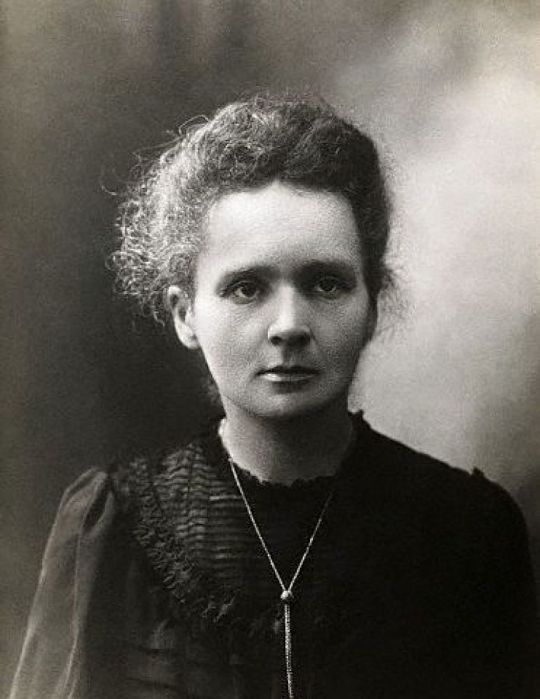
[source]
Soon after taking up her studies at the Sorbonne did Maria realize how far behind the other students she was: they were able to pursue an official education in a free country, something she’d never gotten to experience before. She had been an excellent student back in Poland, a fluent French speaker, but now it turned out her knowledge was lacking. Obviously, this couldn’t discourage her. Bronia’s husband Kazimierz wrote in a letter to her father that Maria would spend entire days at her university, only coming home in the evening. She worked admirably hard to catch up. And she was happy: at long last she could study science and mathematics in depth, the way she had longed to do for so many years.
Of course, money never stopped being an issue. Even with her father’s and sister’s help, she was still poor. She definitely wasn’t eating enough. In winter, she was cold. Other than that, she mostly gave up on her colleagues, refused to waste her time on “insignificant” things: that is, everything but studying, unfolding the secrets of chemistry and physics, practicing her laboratory skills. She was living and breathing science.
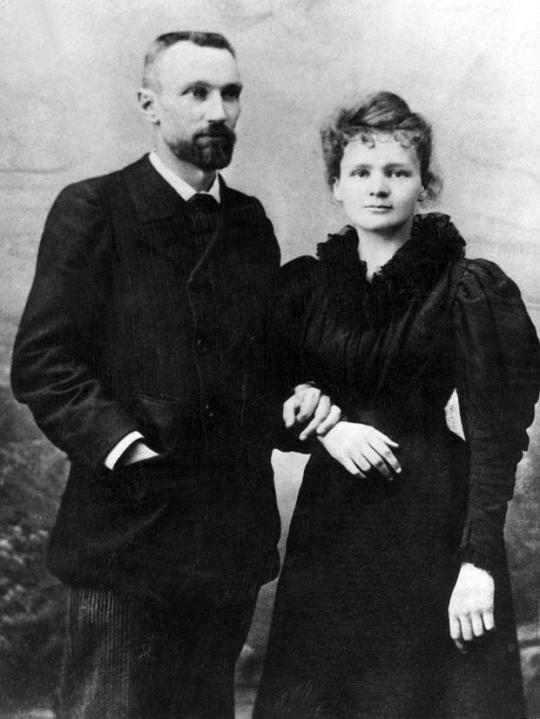
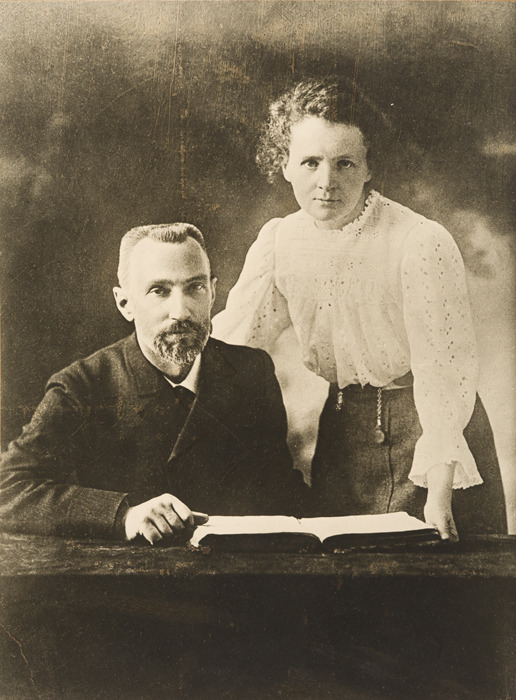
[left / right]
Pierre Curie was older, an exceptional physicist, charming and calm, still unmarried at 35 – he wouldn’t love a woman who couldn’t be first and foremost his intellectual partner. But Maria wasn’t looking for love and she certainly wasn’t looking for a marriage. She had a degree in physics, was on her way to get a degree in mathematics as well, all the while working on the magnetism of steel. And indeed, when they met through a professor who thought Pierre might be of help to young Maria, it was mostly curiosity, mutual respect, and primarily a great scientific interest that bloomed between them and brought them closer together.
Maria didn’t give in easily. All along her plan had been to earn her degrees and return to Warsaw, to her elderly father, and remain working as a teacher for the rest of her life. But there’s no doubt that when she eventually agreed to marry Pierre, it was out of genuine, deep love. They had a sincere, precious connection, both emotional and intellectual.
Did you know Maria and Pierre loved to travel the countryside on their bikes? They did. It’s how they spent most of their time together after their wedding. And not for a moment did they forget about their shared passion for science – they discussed it even during their travels. They lived together and they worked together. Their first child Irène – future Nobel prize winner as well! – was born in September 1897, Ève – their younger daughter – seven years later.
Pierre’s family adored Maria, Maria’s family loved Pierre. The two of them would frequently visit Pierre’s parents and they continued their biking trips, but other than that their life was utterly devoted to science. I know, it sounds like I’m exaggerating, but it’s true. Along with the fact they always had very little money, work was all they had.
Radium appeared in Maria’s life when she was working on her doctorate. Her laboratory was cold, damp, and badly equipped, but it seems to me Maria’s determination was inexhaustible. She began by studying uranium, but she soon figured out she had to include other elements in her research as well in order to solve the mystery at hand. It was only after a year of this work that Maria realized she might have discovered an element previously unknown.
Pierre was interested in Maria’s research before, but – save from the occasional advice as an older and more experienced scientist – he mostly left her to do her own thing while he focused on his crystals. At this point however, he was so intrigued he abandoned his research to work with Maria on her project. In 1898 (two years into Maria’s PhD work!) they published a paper together – in it they announced the discovery of a new element: polonium, named after Maria’s beloved homeland. Later that year, they did the same for radium. They coined the term “radioactivity”.
Maria kept a meticulous journal, not only for her laboratory work. She was carefully tracking their spending as well as Irène’s development, the way she learnt to walk and speak and play with their cat.
And so, her life continued: filthy, hard work in the infamous shed, a ton of an ore for less than a gram of product (!), countless papers published with her dearest husband, watching their daughter grow, earning her doctorate degree; then, in 1903, her first Nobel prize (along with her husband and Henri Becquerel).
The Nobel prize brought Maria and Pierre fame – and it was a tragedy. For them, at least. Modest and humble as they were, they couldn’t stand the journalists almost storming their garden, going as far as “describing [their] black and white cat [in the newspapers]” as Pierre said in a letter to a friend. I allowed myself to translate a piece of a letter that Maria sent to her brother in 1904 amid the post-Nobel craze, as it’s both sad and hilarious:
“I wish you health [for your name-day], well-being for all of your family, and for you never to experience the sort of correspondence and assault that we are now subjected to. Ever since that accursed Nobel prize we’ve been unable to do anything, and I’m beginning to ask myself if the money we received will be of any consolation, as, after all, the people who sell me meat, coal, sugar, etc. are richer than me yet they do not experience such sorrows. […] and yesterday some American wrote to me, asking for permission to name a race horse after me.”
Maria’s life took a truly sharp turn when Pierre died in an accident in 1906. Despite the tragedy that irreparably crushed her heart, she never ceased her work. She became a professor, organized classes for her and her friends’ kids, ran the Radium Institute, continued her research, received her second Nobel prize. During World War I it was her mobile X-ray machines that saved countless lives: she was active and involved, operating the machines with her older daughter and teaching others how to do it.

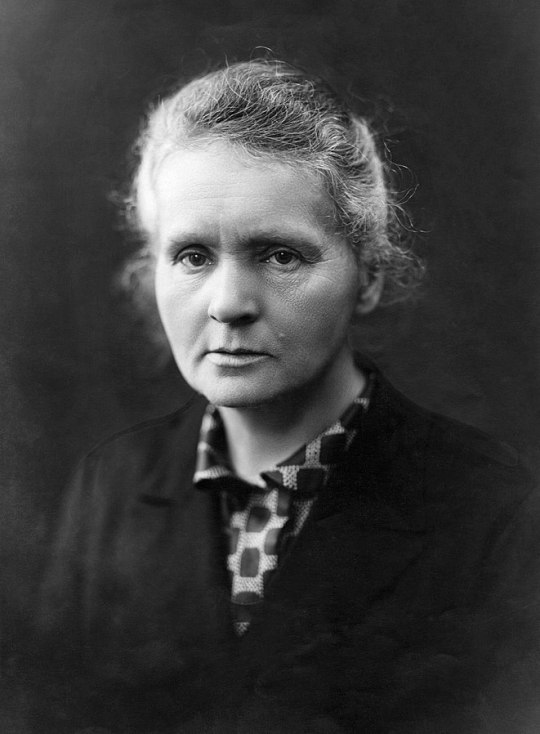
[left / right]
She lived long enough to see her dear, beloved Poland become an independent country once more. To the very end she remained humble and uninterested in fame, hardworking and dedicated entirely to science.
I based this post mostly on Madame Curie by her daughter Ève which I highly recommend!
#in the end i kept it long as you can see#but i think its consistent :)#mine#op#chemistry#chemblr#physics
59 notes
·
View notes
Text
Books to Try if You Loved the Grishaverse

If you liked the magical heists but you wanted more werewolves, vampires, nine-tailed foxes, and fae, try:
Zodiac Rising by Katie Zhao, a YA heist inspired by Chinese folklore.
The fountainheads of the zodiac families have been taken and Evangeline’s older brother has been found dead, with all signs leading to the fae being responsible for both. Evangeline gathers a team of three other students to help her get the statues back, but things are never that simple when you’re on a heist with your ex or enter the fae world.
If you wanted to spend more time inside The Fold and liked the complicated romances, try:
The Gods Below by Andrea Stewart, the first in an epic fantasy trilogy
Two sisters forced on opposite sides of a war when Hakara escapes a godly force that either kills or transforms anyone trapped in it and the younger sister, Rasha, is changed into the god’s image. One sister will never give up hope of reuniting and the other learns the world is a lot more cruel than she originally believed.
If you wanted more Queer stories about destroying your monstrous ex, try:
The Sins on Their Bones by Laura R. Samotin, a standalone MM fantasy inspired by Ashkenazi Jewish folklore
Dimitri was the Tzar, once, before his estranged husband took his place and forced him into hiding with what’s left of his court. With his new lover, Dimitri will destroy Alexey if it’s the last thing he’ll do. But Alexey is not ready ready to left Dimitri go and will do whatever he can to get him back.
You want the heist and the found family and addictive romance, but you wanted a contemporary with no magical elements, try:
Women of Good Fortune by Sophie Wan, a contemporary set in Shanghai
Best friends Lulu, Jane, and Rina plan a heist to steal the money gifted to Lulu and her fiancee on Lulu’s wedding day to fund their dreams. But as they plan, obstacles pop up and some parts of their lives are maybe not as bad as they originally thought.
If you wanted more time in The Fold, destroying your monstrous ex, and you loved the Eastern European-inspired setting but you wanted more witches and dragons, try:
Foul Days Genoveva Dimova, the first in a Bulgarian fantasy duology inspired by the Iron Curtain
Kosara is a witch who willingly gave up her shadow, and her magic, to escape her home and her ex, the zmey. But she’s dying without her shadow. The only way to save herself is to go back and face her past.
If you loved the complicated relationship, you really love the enemies-to-lovers witch x witch hunter romance found in Nina and Matthias’ story, but you wanted a fantasy romance, try:
Heartless Hunter by Kristen Ciccarelli, the first in a YA/New Adult Romantasy duology
Rune is a witch in hiding who has been doing everything she can to save her fellow witches from the witch hunters. Gideon is the brother of Rune’s childhood best friend and a witch hunter out to kill every witch and was traumatized by one of the former witch queens. When the two agree to pretend to court, this cat-and-mouse game will reignite old attractions and heavy prices will be paid
If you loved what Netflix’s Shadow and Bone did with casting Alina and Mal as biracial but wanted more conversations around the complexities of being biracial during colonization and war, try:
Sun of Blood and Ruin by Mariely Lares, a YA historical fantasy first in a planned series inspired by Zorro and Mesoamerican mythology
Leonora has taken the manacle of Pantera, fighting the colonizers every chance she gets to free her people from their oppression while also reconciling with her own identity as a biracial woman in a world where she has to be one or the other.
If you loved the elemental magic and found family but you also love fairy tale retellings, try
The Goose Girl by Shannon Hale, the first of a four book YA fantasy series
Princess Anidori is engaged to marry a man she has never met, Prince Geric. Her maid forcibly takes her place and sends Ani to become the new goose girl of the king. What the maid wasn’t aware of was that Ani has growing magical powers and that her kindness would win her allies to help get her throne back.
If you loved the angst of Kaz and Inej’s love story but want more tragedy, more poetic language, and less fantasy, try:
A Song to Drown Rivers by Ann Liang, a standalone romantic historical retelling the legend of one of the Four Beauties of Ancient China
Xishi is one of the most beautiful women Fanli, an advisor to the emperor, has ever seen, prompting him to ask her to distract the king so a coup can come and overthrow him. Xishi agrees but wanted neither expected was to fall for each other as they prepare to be separated.
#if you liked this try this#grishaverse#shadow and bone#netflix's shadow and bone#ya fantasy#romantasy
16 notes
·
View notes
Text
Warhammer Gaslamp: Geopolitics of the Old World

(For the Introduction, see here; for Imperial Society, see here)
The Empire of Man in 2725 IC is the strongest that it has ever been, which is reflected in its growing position of geopolitical power in the Old World. In addition to the Grand Provinces proper, the Empire has an expanded sphere of influence across the Continent:
The Tzardom of Kislev: existing in personal union with the Empire of Man, by treaty and law the position of Tzar or Tzarina is handed down to the younger son or oldest daughter of the Imperial Family, who in turn must be married to a consort of Kislevian royalty, or vice versa. The Tzardom follows its own legal system and maintains its own armies, but is a full member of the Imperial Zollverein and frequently engages in joint exercises with the Imperial Army of the North.
The Merchant Republic of Marienburg: still one of the great financial and commercial powers of the world thanks to its unique trading relationships with Ulthuan, Cathay, Nippon, and Ind, Marienburg is technically a protectorate of the Empire. In exchange for naval protection for its merchant marine and full membership in the Zollverein, Marienburg agreed to elect each Emperor Stadtholder of the Republic, as long as the Emperor agreed to never travel in person to Marienburg and instead govern through a Marienburger Regent (selected by the Empire from a shortlist drawn up the Legislative Assembly).
The Imperial Province of Sudenland (formerly known as the Border Princes): incorporated into the Empire a hundred years ago in one of the last of the Greenskin Wars, the Province of Sudenland is distinguished from the Grand Provinces of the Empire proper through a complex system of linguistic community-based governance whereby Imperial, Tilean, Hellene, and Bretonnian nations maintain their own courts, churches, charitable institutions, and militias under the "benevolent oversight" of Imperial Representatives. Needless to say, the Foreign Ministry sends many of its best and brightest to diplomatic positions in Sudenland, whereas the Imperial Armed Forces consider it one of the worst postings in the services.
Other Nations:
The Federal Republic of Tilea - a relatively decentralized republic, by law the republic's capital switches every year from city-state to city-state. Considered one of the great cultural centers of the Old World, Tilea is known as much for its operas as its many revolutions led by men in poofy red shirts - although these days, Tilean militaries feature muzzle-loading rifles and horse cannons more than pike squares.
The Two Nations of Estalia - for all its decentralization, Tilea is an oasis of peace and harmony compared to its neighbor to the west, which has been mired in a civil war for decades between the Red Faction with its strongholds in the industrialized east and among the rebellious campesinos, and the Black Faction with its basis among the landlords, the caudillos, and the church in the rural west.
L'Ancien Régime of Bretonnia - still dominated by the chivalry, although they've long ago given up their chainmail in favor of musketeers in feathered hats carrying matchlocks and rapiers, Bretonnia is known for having the finest cavalry in the entire world. Unfortunately in a world dominated by mechanized war, Bretonnia has become a backwards-looking, second-rate power that hasn't won a major war in well over a century. Despite the best efforts of the chivalry to censor radical literature from Marienburg and the Laborer's Guild of the Empire, the peasant majority is increasingly resentful and fractious, with many of the best and brightest emigrating to more egalitarian societies to the north, east, and south. Ça ira...
24 notes
·
View notes
Text
Alright. Onward to talking about what I like from Kislev, the themes, and what headcanons or things I feel could be improved.
Honestly, the thing I enjoy most is the Ice Court. Katarina and the rest of their Ice-magic ladies are the coolest (hehe) part of the whole faction. Yeah it's neat to have people riding bears. Kossars and the like having both guns and spears and the efficiently brutal simplicity of the kingdom/faction is nice. Regional boyars in charge of villages and mostly just pay the tax for whatever structuring the kingdom needs or have people head off to war when mass defense is needed is a decent fantasy setting vibe.
But the Ice Court tho. It's similar to magically capable Bretonnian women going off to the Fay Enchantress (we'll get there eventually), or mandatory magical schooling. But as the last post mentioned, to the Empire (largely the POV faction for so much written works with the in-universe writing style GW maintains) it's a religious appointment to join the Ice Court. The frost maidens have a kind of magic drawn from the frigid north and the elemental spirits there. Arguably, it means their magic wouldn't work (or at least work as well) farther south in the warmer climates.
I'd love to see similar splinter factions or expansion on Cathay/Ind/Araby that use magic drawn from other nascient or elemental spirits on the world. It's part of what I enjoy so much about Wood Elves as well. A people whose closeness to their lands or environment drawing power from and giving power back to the place they dwell.
The fantasy Russia aesthetic is quite nice. Tzar-Era Russian (Slavic as a whole really) architecture and clothing looks cool and works great for a people in a frigid tundra landscape.
Other prominent Kislevites like Boris Ursus, Kostaltyn, Mother Ostyanka and Ulrika are also fascinating looks at the culture (As GW is actively re-writing them for the 'new' The Old World) since they cover the traditional masculine leader, the religious zealotry of the (also new) Orthodoxy, the Hag or Hedge witch perspective of the farther out areas, and finally Kislev's different perspective from the Empire on the nature of magics impacting more than just the Frost Maidens.
In all honesty, I might buy Tzarina Katarina and Ukrika miniatures if GW put some out for the eventual Kislev release (assuming they look good/nice) if only to paint and have them (since I doubt I'll wanna play Kislev as a tabletop army.).
So from the thematically relevant elements (hehe) in Kislev I definitely get historical Russian/Slavic vibes. But also elements of like Elsa or Iceman from Disney and Marvel respectively. (The most difficult thing for me as a very tabletop Role-playing oriented individual is that so few games allow for ice powers the way I want. Even the Warhammer rpg lacks anything for this D: )
I feel like I could ramble on more about Kislev but I'm going to call it here and put out my usual ask of message me, send an ask or reblog if I got anything wrong or if you just wanna chat about Warhammer.
Thanks for reading!
10 notes
·
View notes
Text

Emperor Nicholas I (1796 - 1855) and Empress Alexandra Feodorovna (1798 -1860 - nee Princess Friederike Luise Charlotte Wilhelmine of Prussia
Nicholas I, the Iron Tzar, and his sons
This couple was the first “Nicholas and Alexandra” in the Romanov Dynasty. They were Nicholas II's great grant-parents.
It was said that he was the best-looking man in Europe. She was tall and fair and enjoyed jewels, gowns, and balls. They loved each other, and their union was not unhappy, but he did not remain faithful to her (after he died, his last mistress was employed as Alexandra’s lectrice, and they became friends.) Nicholas and Alexandra had seven children, four sons, and three daughters. Those four sons would ensure that the generation of Romanovs following them would not want for male heirs. As a matter of fact, there would be too many Grand Dukes, making it necessary for his grandson, Alexander III, to change the Pauline laws, re-defining who would be considered a Grand Duke or Duchess, among other things (only grandsons/grandaughters of a Tzar would be Grand Duke/Duchesses; great-grandsons and so on would be Princes and Princesses of the blood).

Nicholas I with his four sons: Tsarevich Alexander Nikolayevich (1818 - 1881 - future Alexander II), Grand Duke Konstantin Nikolayevich (1827 - 1882), Grand Duke Nikolay Nikolayevich (1831 - 1891), and Grand Duke Mikhail Nikolayevich (1832- 1909.)
According to the literature, Nicholas raised his two elder sons very strictly but had more of a paternal relationship with the younger two. His priority was to bring them up so that they were true soldiers and so that when Alexander inherited the throne, the other three would help and support him. And they did. Nicholas I adored his daughters and was devastated when his youngest daughter Alexandra (better known as Adini), died. (His daughters would be discussed in another post.)
Below are the sons of Nicholas I and their spouses:
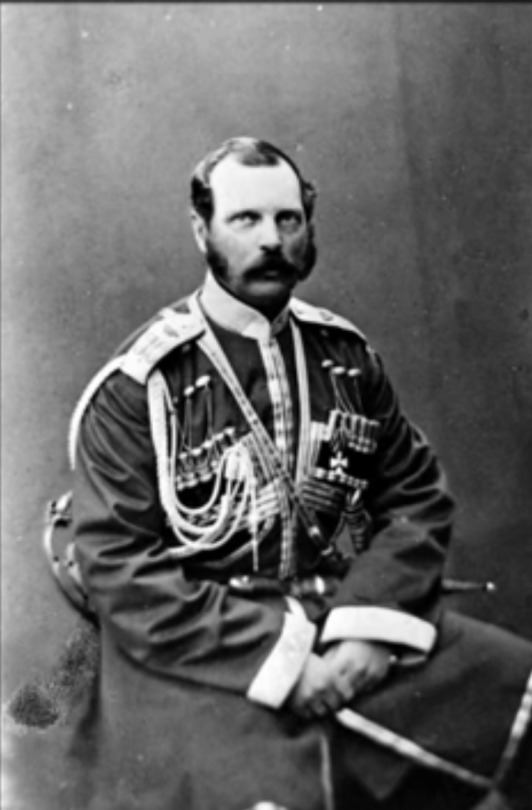

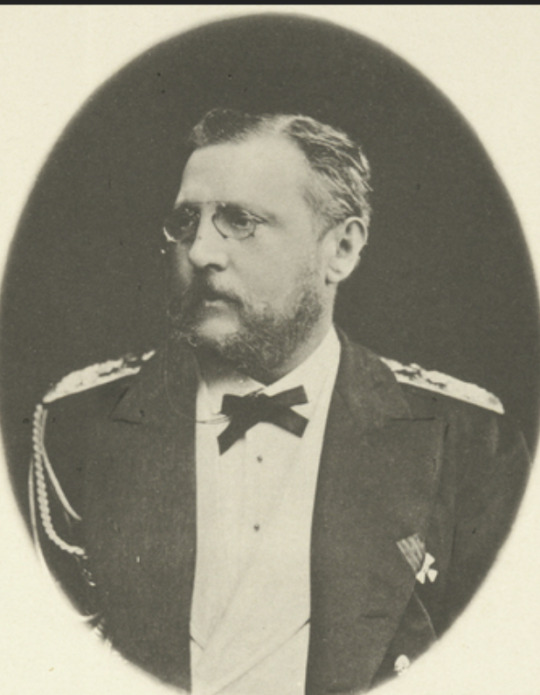
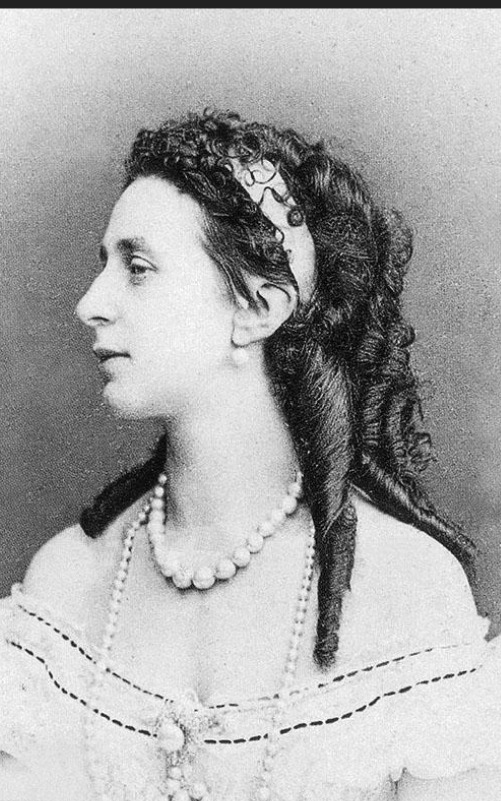




1. Emperor Alexander II and his first wife Empress Maria Alexandrovna (born Princess Wilhemine Marie of Hesse); Issue listed below (Only legitimate issue surviving to adulthood listed; not in birth order)
Grand Duchess Marie
Grand Duke Nicholas Alexandrovich
Alexander III
Grand Duke Vladimir
Grand Duke Alexei
Grand Duke Sergei
Grand Duke Pavel
2. Grand Duke Konstantin Nikolayevich and Grand Duchess Alexandra Iosifovna (Princess Alexandra of Saxe Altenburg); Issue listed below (Only legitimate issue surviving to adulthood listed; not in birth order) - They would be known as the "Konstantinovichi"
Grand Duke Nicholas
Grand Duke Konstantin
Grand Duke Dmitry
Grand Duke Vyacheslav
Grand Duchess Olga
Grand Duchess Vera
3. Grand Duke Nikolay Nikolayevich (the Elder) and Grand Duchess Alexandra Petrovna of Russia, born Duchess Alexandra Frederica Wilhelmina of Oldenburg. Issue listed below (Only legitimate issue surviving to adulthood listed; not in birth order); Known as the "Nikolayvichi”
Grand Duke Nicholas Nikolayevich
Grand Duke Peter Nikolayevich
4. Grand Duke Mikhail Nikolayevich and Grand Duchess Olga Feodorovna (nee Princess Cecilie of Baden) Issue listed below (Only legitimate issue surviving to adulthood listed; not in birth order) They were known as the "Mikhailovichi" (although they preferred to be called the "Michels;" the family called them the "Wild Caucasians" because they grew up in the Caucus and had strong opinions that they voiced loudly)
Grand Duchess Anastasia Mikhailovna
Grand Duke Nicholas Mikhailovich
Grand Duke Mikhail
Grand Duke George
Grand Duke Alexander
Grand Duke Sergei
Grand Duke Alexei
The children and grandchildren of these couples would be directly involved in one way or the other in the Great War, the Russian Revolution, the Civil War in Russia, and the overthrow of the monarchy and the Romanov Dynasty. Some would lose their lives, others would lose children, brothers, and spouses, and all would lose their country, status, and privileges.
#russian history#romanov dynasty#imperial russia#Emperor Nicholas I#Emperor Alexander II#Grand Duke Konstantin Nikolayevich#Grand Duchess Alexandra Iosifovna#Grand Duke Nikolay Nikolayevich#Grand Duchess Alexandra Petrovna of Russia#Grand Duke Mikhail Nikolaevich#Grand Duchess Olga Feodorovna#vintage photography
92 notes
·
View notes
Note
Can I get any more hints for the challenge? Perhaps a list of fandoms you like, or a reworded clue?
Ok, it's even a good idea to write down what things I like. Especially since lately I have been often asked to draw something or to make a cross with something that I only know it exists.
I divided the list into categories to avoid any doubts (e.g. BATIM is only in the games category, 'cause I haven't read the books and I don't plan to read them yet, and W.I.T.C.H. in comics, 'cause I hate the animated series).
Books: (here list is really long so I write only these very popular)
Discworld and others from sir Pretchett
The Lord of the Ring, Hobbit
Harry Potter
Agatha Christie's books
Jane Austen's books
Maria Rodziewiczówna's books
many old Polish authors (like Sienkiewicz)
Movies:
almost all from Disney
almost all from Pixar
Ghost Busters
almost all from DreamWorks
Beetlejuice
old Star Wars
LotR, Hobbit but not really
strange French animations
old Polish movies (like Odwrócona Góra)
Scooby Doo but not all (hate live actions especially)
Smurfs
Not all - Pokemon
Deadpool
Jurassic Park
good ol' classical movies like Terminator, Mission Impossible or Fifth Element
Animated serials:
Gravity Falls
Scooby Doo (ALL of them)
Star Butterfly
The Owl House
old Polish series (i.e. Dixie or Koziołek Matołek)
MLP (almost all generations)
She-Ra and the Princesses of Power
Spider-man (almost all)
Batman (not all, but Brave and Bold is my fav one)
Kipo
Rick and Morty (but last seasons were meh)
Phineas and Ferb (whole universum)
Smurfs
Duck Tales
Dead End: Paranormal Park
Steven Universe
Teen Titans (yes, Go! also)
Pokemon
Loony Tunes
Merry Melodies
Craig from the Creek
Grim Adventures of Billy and Mandy
other CN stuff I guess?
Comics:
Donald Duck (and others)
W.I.T.C.H.
Deadpool
Hellsing
The Bridge's Stories
many online series like Erma, Vampire's Husband etc.
Pokemon Special
Games:
Chrono Trigger (world best game - you cannot change my mind)
BATIM
The Sims
Don't Starve Together (+ Don't Starve)
The Night of the Rabbit
Pokemon (all of them I guess)
Fallout Shelter
Team Fortress 2
Planet Zoo
Timberborn
Settlers
Sid Meier's Civ
Heroes of Might & Magic (but not IV)
Terraforming Mars
Talisman
Magic the Gathering (TCG)
Death and Taxes
many point&click
Tzar
Aztec Wars
Jazz Jackrabbit 2
Worms
Inscryption
Graveyard Keeper
It's not a complete list, just the things I remember at this moment :)
3 notes
·
View notes
Text
The Sins on Their Bones review
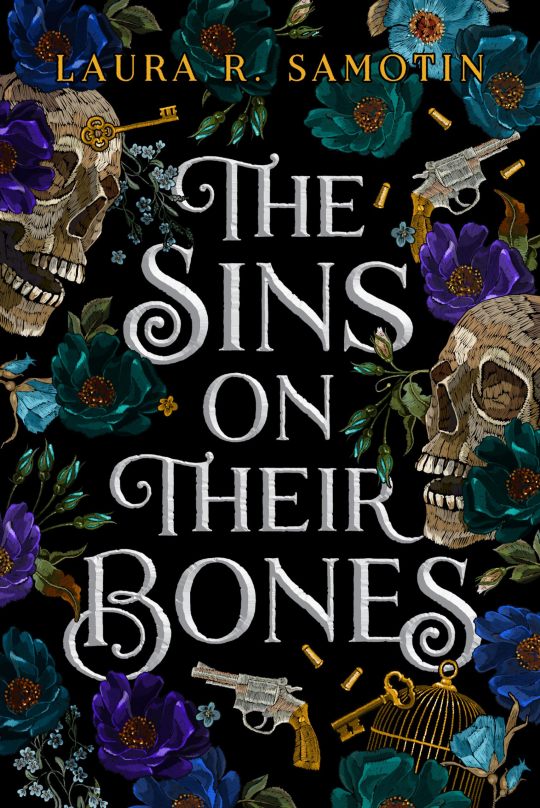
4/5 stars Recommended if you like: fantasy, historical fantasy, LGBTQ+ characters, political intrigue, Russian Revolution
Big thanks to Netgalley, Random House, and the author for an ARC in exchange for an honest review!
TW rape/SA, spousal abuse
This definitely seems to be a book that you absolutely love or that you struggle with. I obviously thought this book deserved 4 stars, but I did struggle immensely with getting through the book. The pacing is very slow and it takes a while for the plot and the characters to really warm up. I do feel like a good portion of the first 50% could be cut without damaging the story.
Without a doubt this is a story about suffering and about healing. Dimitri, one of the MCs and narrators, is in terrible amounts of pain after what occurred with his husband and the revolution. He's the one we see suffering the most, but the book does follow his journey as he begins to heal and discover who he is on the other side of those things. Vasily, another one of the narrators, has pain in his past that is alluded to over the course of the novel. He's at a different stage of the healing process than Dimitri, but that pain and healing is still there.
I think part of the problem with the book's pacing is that Samotin strives to show a realistic journey of pain, depression, and healing, and that path is not a quick one. Dimitri does not recover over night or in the span of a chapter. He first needs to recognize that he can heal and then he continually needs to make that choice. I do think it's a realistic depiction, and I applaud Samotin for showing that. However, I think time jumps could have, and probably should have, been used.
Setting aside the pacing, I was fascinated by the setting of this book. It takes place in a fantasy, Jewish-majority version of Russia circa the Russian Revolution. The setting is rich with architecture and clothing and traditions. I liked the interplay of the different sects of religion in the novel and how that was used to create tension between characters who followed Ludyazist mysticism vs. those who followed the (not-so) Holy Science. I also thought it was interesting to read a book where a fantasy version of Judaism is the predominant religion instead of having it be a fantasy version of Christianity.
Dimitri is the main character, imo, even though there are three narrators. As mentioned above, this is very much a healing story, and Dimitri has a lot to heal from. He was the Tzar of Novo-Svitsevo prior to the revolution and he desperately loves his country. He also desperately loves his husband, who overthrew him and is just generally a not great (read: abusive) dude. Dimitri is grappling with the consequences of war and the feeling he let his country down, as well as the guilt associated with helping place his husband, Alexey, in a place to do that in the first place. But he's also recovering from the abuse Alexey put him through and coming to terms with the fact that it wasn't his fault. Beyond all of these things, Dimitri is extremely loyal and it's clear he loves his friends dearly.
Vasily might be my favorite narrating character. He's Dimitri's spymaster and fled with him into hiding after the end of the war. He blends humor and seriousness well and is able to stabilize situations fairly well. I liked seeing him work, I always think it's fascinating to see a character become someone else as a spying/manipulation tactic. He has his own past trauma that gets revealed a bit throughout the book, though he's further along on his healing journey than Dimitri is.
Alexey is the last narrating character and he was Dimitri's husband. Through experimentation with the Holy Science, Alexey has become immortal and is impossible to kill. He was already tempestuous and abusive, but post-immortality and post-war, he's only become more volatile. He strives to create and control an army of demons in order to make Novo-Svitsevo the strongest country in the world. But despite his delusions of grandeur, most of his court is terrified of him and he has little patience for what it means to run a country. Alexey is not portrayed as the good guy in any way, but his POV is one of an abuser, so keep that in mind.
I enjoyed the side characters on Dimitri's side of things. Other than Vasily, there are three other members of his court who fled with him and they are Annika, his general; Ladushka, his strategist; and Mischa, his physician. They each felt like well-rounded characters with their own pasts and idiosyncrasies. I would've liked to know a bit more about them but the pacing of the book makes that difficult.
Overall I think this book had a lot of potential. The pacing definitely got in the way of the plot and I think a good portion of the beginning of the book probably could've been cut. I liked the side characters more than the main characters as well, so that could've contributed as well. That being said, the characters have a lot of depth to them and the setting + magic system were interesting.
#book#book review#books#book recommendations#fantasy#booklr#bookstagram#bookblr#bookaholic#bookish#netgalley#netgalley review#netgalley read#advanced readers copy#the sins on their bones#russian revolution#historical fantasy#adult fantasy#lgbtq characters#political intrigue
8 notes
·
View notes
Text

"One evening a notice was posted up begging the guests not to pursue, persecute, or mob the Tzar of Russia, who was staying at Friedberg, three miles off, and who came in every day with the Tzaritza and her children. Poor Alix of Hesse, mortally ill, had turned as a last resource to the healing waters of her native province and her husband had complained that the Nauheimers followed him and her about and stared. This would, if continued, prevent him from coming to that place. It must be stopped. It was.
There was more than fear of mobbing ; there was the fear of the bomb. He went in danger of his life so obvious and so imminent that the craven and businesslike municipality of Friedberg had insisted on his insuring the public monuments of that place at his own expense! It was his chamberlain's duty to disseminate fallacious announcements of his movements. When he was supposed to be going to the baths it was at the Kursaal you would find him ; when it was the riding school it was much more likely to be the lake. I have seen him there, a disconsolate figure, encouraging his boy to sail his tiny boat or being rowed about in one. I certainly never mobbed him. In the same accidental way I often saw the Tzaritza, in black with pearls, going in and out of the baths, her face a tragic mask, stupid, incompetent, haughty, dejected. She looked a lovely fool ; nay, hardly lovely now — the morbid shadow of a queen. And once I saw him through the windows, like glass walls, of a shop full of Venetian glass, Japanese netsuke, and plaques of green jade. The shopman was showing him some objet d'art or other, and the Tzarewitch, whose head did not come up to the counter, was with him. No one else. The door of the shop had been left open, and some sensible German passer-by had shut it. Nicholas II looked up and out — he thought he was trapped ! I saw his face through the beautiful clear glass ; it did not exhibit mere terror, for he was a brave man, but all at once it seemed implicit with a summing-up, a resume of the composite agony of all this race of kings consciously marked down for destruction. His grandfather before him — his uncle — and only the little son with his head below the counter to carry on the monstrous imposthume of Russian Royalty!"
Violet Hunt "The flurried years"
5 notes
·
View notes
Photo

Profiles in Villainy
Rasputin
The mad monk and malevolent mystic known as Grigori Rasputin had previously been a spiritual advisor to the royal Russian family. Cunning an ambitious, Rasputin’s ambitions to destroy the Russian monarchy was found out and the monk was banished by Tzar Nicholas Romanov II.
Using his knowledge of the black magical arts, Rasputin sold his soul to a demon in exchange for the supernatural abilities needed to gain deadly revenge on Tzar Nicholas and his family. Now a lich (a type of undead ghoul possessing magical powers), he enacted the ‘Romanov Curse,’ resulting in the deaths of nearly all of the Romanov family; save for the youngest daughter, Anastasia, who managed to escape.
Rasputin’s familiar, the bat named Bartok discovered that young Anastasia was still alive and reported back to his master. Upon learning of Anastasia’s survival, Rasputin endeavored on a diabolical scheme to do in the last surviving Romanov.

Now a teenager and unaware of her true origins, Anastasia managed to evade Rasputin’s deadly efforts. She discovers the truth about herself and was finally able to defeat Rasputin. With the aide of Bartok, Anastasia was able to destroy the villain’s reliquary. This acted to release the demons who originally imbued the monk with his powers. Angered over Rasputin’s failure, the demons collected his soul and dragged the villain into hell.
Although Anastasia was able to survive and went on to live a full life of her own, Rasputin’s actions ultimately resulted in the fall of the Russian monarchy and the rise of the Soviet Union.
Actor Christopher Lloyd provided the voice for the mad monk (with Jim Cummings in the singing sections). This iteration of Rasputin first appeared in the 1997 animated feature, Anastasia.
#Profiles in Villainy#Rasputin#Anastasia#Bartok#Christopher Lloyd#Jim Cummings#cut-out#paper art#Villains!
23 notes
·
View notes
Note
That story…the weird derogatory comparison of the kid to a siberian…????
If I understood correctly, this is talking about Fedko-brigand story? Ok, thanks for bringing your concerns up, because I wouldn't have considered the word choice needs explanation, but the it really does and it's a shame the translator didn't do it themselves.
So, this is the paragraph anon is talking about:

Here is an important cultural context: both soviet union and imperial russia used a practice of sending prisoners to far east, especially to Syberia. If you'll allow me an analogy, Syberia was the same thing for russian empire as Australia was for the British one. Sometimes people who got deported were no criminals at all, but rebels, or innocent victims of the governmental repressions (like, for example, during the wave of mass deportations in 1947). So, because for a contemporary ukrainian Syberia was only brought up in the context of prisoners and criminal punishment, the word "сибіряка" which is translated here as a "syberian" gained a meaning of "criminal, villain". And, really, the last two words would have been a much better translation.
For example, here is a recollection where our national poet, Taras Shevchenko, is called by his contemporaries a "syberian" - he obviously wasn't born in Syberia, but he was sent to east (not even to Syberia, but to Kazaksstan) as a punishment for his anti-tzar activism.

On top of this, the subtle difference between "syberian" as a name for a person from Syberia and a "syberian" as a synonym for a criminal is in one letter in ukrainian, that is totally lost in translation: "сибіряк vs сибіряка"
Fun fact that is really disturbing if you think about it - if you look at ethnic map of modern russia, you'll notice that in Syberia there are a lot of people with suspiciously slavic background as opposed to more asian you'd expect from the region. Wikipedia states that as of 2010, at least half of the syberian federal district are ethnic ukrainians (although, from what I've heard, they are completely russified). That is not natural - that is the result of russian and soviet criminal systems.
In the end, I feel like I should apologise. I did share the story without reading the translation through - just relying on my own memory of the text (from reading it in ukrainian) and a recommendation from twitter. I should have been more thorough and I carry part of the responsibility.
#like don't get me wrong reading classic ukr lit there are many times I myself am shocked with the unapologetic xenophobia of the author#but in this particular case it isn't that
33 notes
·
View notes
Text
I love really strong russian black tea because if I drink it at just the right time it's mm ah delicious, but if I let it steep a moment too long suddenly I am drinking bitter poison in a tiny teacup. Particularly this Tzar Alexander ll tea. I always throw the last finger of tea back like a shot and make the face of a grizzled detective seeing the grave of his deceased wife

#tea time#just tea#the first time i drank it i was genuinely worried it was poisoned or rancid then i realized i had a weak little herbal tea pallet#black tea#teateaateaeetea#yummy yum yum
9 notes
·
View notes
Text
i think nicholas the second, last tzar of russia, was getting fucked crazy style on the daily by rasputin's freaky ass. ain't no way that man was that close to the tzar, throwing orgies in the palace or whatever, and never got freaky with famously feminine pretty boy with a dragon tattoo nicholas ii. the assumption was always that he was fucking nicholas' wife (and he might have been) but it was 100% nicholas too you can't convince me otherwise
2 notes
·
View notes
Text
Feodorovsky Gorodok and Feorodovsky Cathedral

FEODOROVSKY GORODOK
Across Alexander Park, down the path from the Alexander Palace, is Feodorovsky Gorodok, a tiny old Russia-style town built by Nicholas II in the first decade of the 20th century. The Tzar wanted the town to have the atmosphere of an old Russian town. This historic atmosphere would frame the Alexander Palace.
The Feodorovsky Gorodok (Town), included the Feodorovsky Sovereign Cathedral, the Martial Chamber, the infirmary of Grand Duchesses Anastasia and Maria, the former barracks of His Imperial Majesty’s Own Convoy, and the Tsar’s Railway Pavilion. There was much more Nicholas wanted to do in the Gorodok, but the First World War halted his plans, while the revolution ended them completely. The buildings surviving unchanged are the Feodorovsky Cathedral and the Martial Chamber (now the Museum of the History of the First World War).
Reportedly, the restoration of the Gorodok has begun. The area has not been completely abandoned: A fully functioning privately owned restaurant is in one of the courtyards. The former Grand Duchesses Maria and Anastasia’s infirmary and the buildings in the courtyard behind it have been converted to boarding rooms for the elderly who are too poor to afford housing and food.


1. The Tsarkoe Selo Train Station as it stood in the 20th century 2. What is left of the station, which is being restored
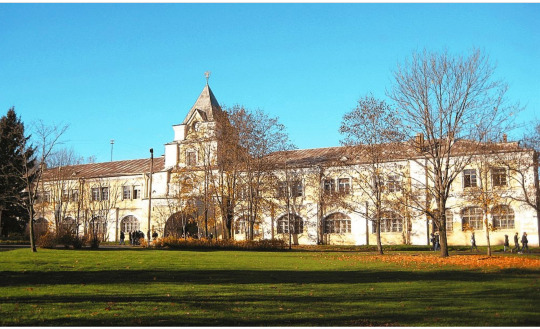
3. The barracks of his Imperial Majesty's Own Convoy

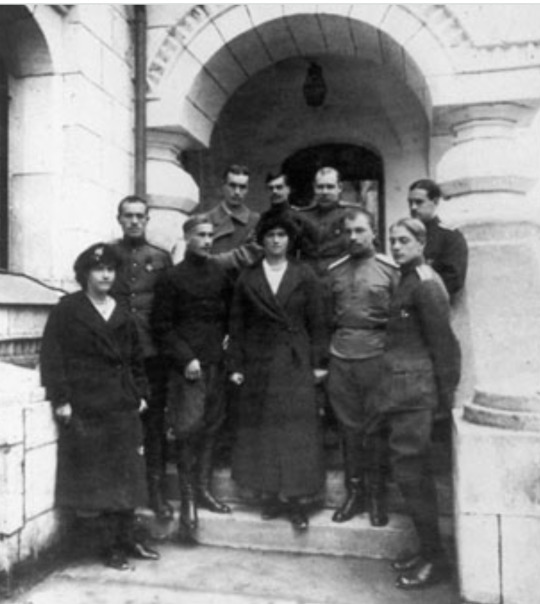
4. Maria and Anastasia's Infirmary. 5. Maria and Anastasia posing with officers at the entrance of the infirmary.


6. Badly damaged wall and tower. 7. Restoration work taking place.

FEODOROVSKY SOVEREIGN CATHEDRAL
The foundation of the Cathedral was laid on 20 August 1909, in the presence of Emperor Nicholas II and his family. The construction was financed by the tsar’s family.
The Feodorovsky Sovereign Cathedral became the house church for Emperor Nicholas II and his family. The Cathedral consisted of two churches, the upper which included the main altar dedicated to the Feodorovsky Icon of Our Lady and a side-chapel consecrated in honor of the Moscow Metropolitan Alexis, the all-Russia Miracle-Worker. The lower part of the Cathedral housed a Cave Church with the altar consecrated in the name of Saint Serafim of Serov the Miracle-Worker, and the private chapel of Emperor Nicholas II and Empress Alexandra Feodorovna. The Feodorovskaya icon of Our Lady, the main icon of the Cathedral, is the patroness of the Romanov dynasty. The icon was kept in the upper church.
In 1913-1917 the Martial Chamber complex was built near the cathedral. At the start of the war against Germany in 1914 it was decided to open a portrait gallery of the holders of the St. George Cross in the Chamber building. In 1918 the art collections were divided among various museums in Leningrad.
In 1991 the Feodorovky Sovereign Cathedral opened its doors to believers again. The entire complex of buildings is closely connected with the Russian Orthodox Church and with the life of the last Russian Emperor; the church allocates funds for the restoration work. The Feodorovsky Sovereign Cathedral was reconsecrated on 29 February 1992. Regular liturgies are carried out in the Cave Church. Renovation of the Cathedral was finished in 2013, the 300th anniversary of its original construction.







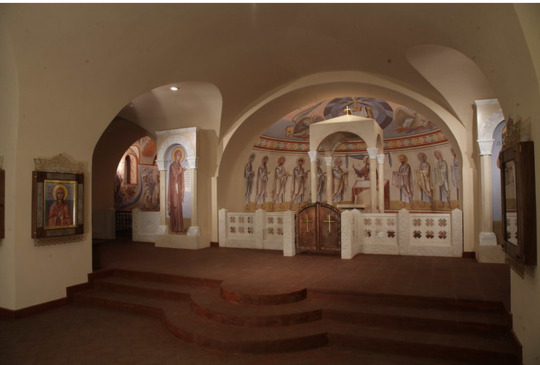
Inside view - the icons of Alexandra and Nicholas can be seen in the background
Main entrance
Outside view of the cathedral and a bust dedicated to Nicholas II
A view of the inside
Entrance to the "cave church" where the Emperor and his family worshipped
The Emperor's Stairs (to the lower church)
The lower church as it looks today. No photos were located for the intimate atmosphere of this chapel to be recreated. The design is modern.
#russian history#imperial russia#romanov family#Tsarkoe Selo#Nicholas II#Feodorovsky Godorov#Feodorovsky Sovereign Cathedral#OTMA
12 notes
·
View notes